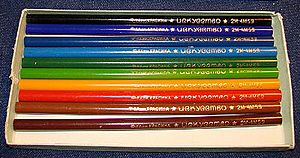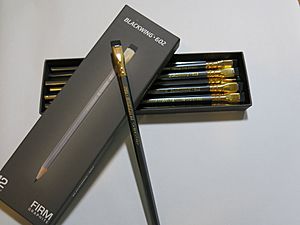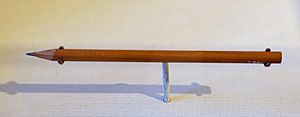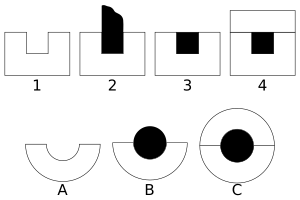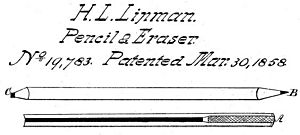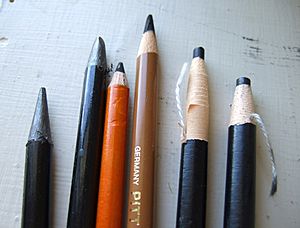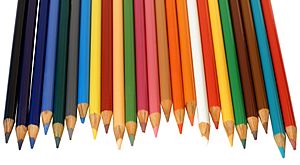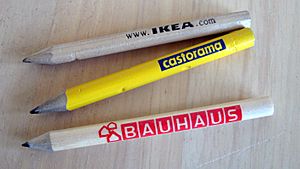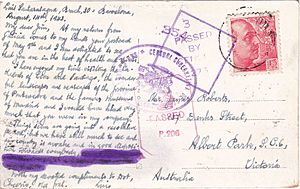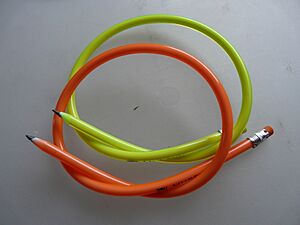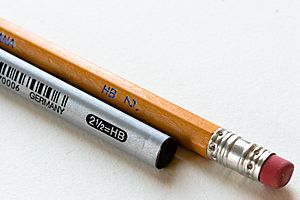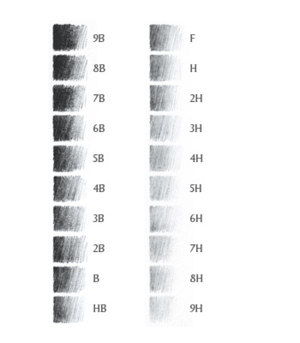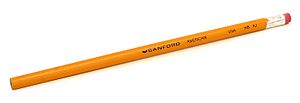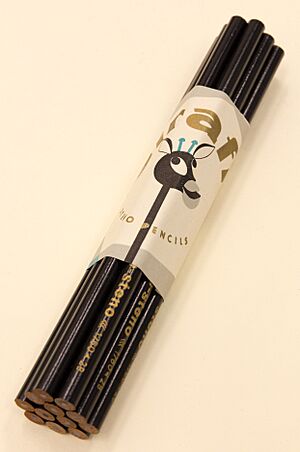Pencil facts for kids
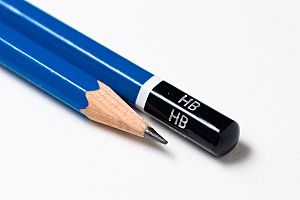
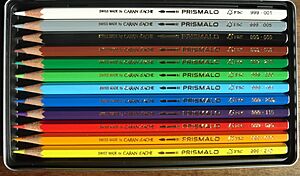
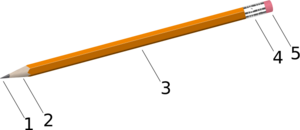
- Solid pigment core (typically graphite, commonly called pencil lead)
- Wood
- Painted body
- Ferrule
- Eraser
A pencil is a tool for writing or drawing. It has a solid color stick, called a core, inside a protective cover. This cover stops the core from breaking easily and keeps your hands clean.
Pencils make marks by rubbing their core material onto a surface like paper. This is different from pens, which use liquid ink.
Most pencil cores are made from graphite powder mixed with clay. These graphite pencils, sometimes called "lead pencils," make grey or black marks. You can easily erase them, and they don't smudge much with moisture or sunlight. Other pencils, like charcoal pencils, are mostly for art. Coloured pencils have cores with pigment and are great for drawing or coloring. Grease pencils have a soft, oily core that can write on smooth things like glass.
The most common pencil cover is thin wood, often shaped like a hexagon. Sometimes they are round or triangular. To use a pencil, you sharpen the wood to show the core. Mechanical pencils have special covers that hold separate, movable cores. You can push these cores out or pull them back in. When a core runs out, you can put a new one in.
Contents
History of Pencils
Early Writing Tools
The word "pencil" first meant a fine artist's brush, often made of camel hair. People used these brushes for writing before modern pencils existed.
Long ago, the Romans used a tool called a stylus. It was a thin metal stick for scratching marks onto papyrus or wax tablets.
Discovering Graphite
The pencil we know today started to appear around 1565. This was when a large amount of graphite was found in Borrowdale, England. This graphite was very pure and solid. People could easily cut it into sticks.
At first, people thought graphite was a type of lead. That's why pencil cores are still often called "lead," even though they don't contain the element lead. In many languages, the word for pencil still means "lead pen."
The graphite from England was very valuable. It was used to make molds for cannonballs. The mines were guarded, and the graphite was even smuggled out of the country.
Because graphite is soft, it needed a cover. Early graphite sticks were wrapped in string or sheepskin. Later, in 1662, a way to make graphite sticks from powder was found in Germany. England kept making its unique square pencils from natural graphite until the 1860s. Today, you can visit the Derwent Pencil Museum in Keswick, England, near where graphite was first found.
Wood Pencil Covers
Around 1560, an Italian couple, Simonio and Lyndiana Bernacotti, likely made the first plans for a wood-covered pencil. Their idea was to hollow out a stick of juniper wood. Soon after, a better way was found: two wooden halves were carved, a graphite stick was placed inside, and the halves were glued together. This is still how many pencils are made today.
Graphite Powder and Clay
The first try at making graphite sticks from powdered graphite happened in Germany in 1662. They used a mix of graphite, sulphur, and antimony.
During the Napoleonic Wars, France couldn't get pure graphite from England. So, in 1795, Nicolas-Jacques Conté found a new way. He mixed powdered graphite with clay and baked it in a kiln. By changing how much clay he used, he could make the pencil lead harder or softer. This method is still used today. The Koh-I-Noor company in Vienna patented this process in 1802.
Pencils in the United States
Early American colonists bought pencils from Europe. Benjamin Franklin sold pencils in 1729. George Washington used a 3-inch pencil when he explored in 1762.
In 1812, William Munroe made the first American wood pencils in Massachusetts. Henry David Thoreau, a famous writer, also found a way to make good pencils from lower-quality graphite using clay. This helped his father's pencil factory.
Another person, Ebenezer Wood, automated pencil making in Massachusetts. He used the first circular saw for pencils and created the hexagon and octagon shapes. He shared his ideas freely. Eberhard Faber used these ideas to build a factory in New York and became a top pencil maker.
Joseph Dixon also found a way to mass-produce pencils. By 1870, his company was a huge graphite dealer. It later became the Dixon Ticonderoga company we know today.
By the late 1800s, Americans used over 240,000 pencils daily. Red Cedar wood was popular for pencils because it smelled nice and didn't splinter. When Red Cedar became scarce, companies started using incense cedar, which is now common. Over 14 billion pencils are made worldwide each year.
Adding Erasers
On March 30, 1858, Hymen Lipman got the first patent for attaching an eraser to a pencil. This made pencils even more useful!
Pencil Extenders
Sometimes, pencils get very short from sharpening. Before mass production made pencils cheap, people used "pencil extenders." These tools held a short pencil stub, letting you use it until it was tiny. Artists still use extenders to get the most out of their expensive colored pencils.
Types of Pencils
By What They Mark With
Graphite Pencils
These are the most common pencils, usually in wood. They are made of clay and graphite. They range from light grey to black and make smooth marks.
Solid Graphite Pencils
These are solid sticks of graphite and clay, without a wood casing. They are often called "woodless" pencils. Artists like them because they can cover large areas easily and are used completely.
Liquid Graphite Pencils
These pencils write like pens but use liquid graphite. They were first invented in 1955.
Charcoal Pencils
Made of charcoal, these pencils create very dark black marks. They can smudge easily and feel rougher than graphite. You can also find sepia (brownish) and white charcoal pencils.
Carbon Pencils
Carbon pencils are made from clay and lamp black. They make a deep black mark, are smoother than charcoal, and don't smudge much. They blend well, like charcoal.
Colored Pencils
Colored pencils have wax-like cores with pigment (color) and other materials. You can blend different colors together.
Grease Pencils
Grease pencils can write on almost any surface, including glass, plastic, and metal. They often come wrapped in paper that you peel off.
Watercolor Pencils
These pencils are for watercolor art. Their cores can be mixed with water. You can use them dry for sharp lines, or add water with a brush to spread the color.
By How They Are Used
Carpentry Pencils
Carpenter's pencils have a special flat shape so they don't roll away. Their graphite is also very strong. The oldest pencil ever found is a German carpenter's pencil from the 1600s.
Copying Pencils
Copying pencils have a dye added to their graphite. This makes a mark that won't fade. If you wet the mark, it turns into colored ink. They were used a lot until ballpoint pens became popular. In Italy, they are still used for voting ballots.
Eyeliner Pencils
Eye liner pencils are used for make-up. Unlike copying pencils, they contain safe, non-toxic dyes.
Erasable Coloring Pencils
These colored pencils can be easily erased, unlike wax-based ones. They are good for sketching or when you need to erase mistakes. Animators like them because they don't smudge as much as graphite.
Non-Reproduction Pencils
These pencils make marks that don't show up on photocopiers or other copying machines. They are often called "non-photo blue" pencils.
Stenography Pencils
Stenographer's pencils, or steno pencils, are very reliable. Their lead is strong and doesn't break easily. They are often sharpened at both ends and are round for comfort during long writing sessions.
Golf Pencils
Golf pencils are usually short (about 9 cm) and cheap. Many libraries offer them as disposable pencils for quick notes.
By Shape
- Triangular (like a Reuleaux triangle)
- Hexagonal (six-sided)
- Round
- Bendable (made of flexible plastic)
By Size
Typical Pencils
A standard hexagonal "#2 pencil" is about 19 cm long. Its width is about 9/32 inches (7 mm).
Biggest Pencil
On September 3, 2007, Ashrita Furman showed off a giant pencil. It was 76 feet (23 meters) long and weighed 18,000 pounds (8,165 kg)! It was a birthday gift for his teacher.
By How They Are Made
Mechanical Pencils
Mechanical pencils use a system to push the lead out. Some push the lead out from inside, while others just hold the lead in place. You can replace the erasers and add new lead refills. Mechanical pencils are popular because they last a long time and don't need sharpening. Lead sizes vary, like 0.50 mm or 0.70 mm.
Pop a Point Pencils
Also called "Bensia Pencils" or "stackable pencils," these have many short pencil tips inside a plastic holder. When a tip gets dull, you pull it out and put it in the back. This pushes a new, sharp tip to the front.
Plastic Pencils
Invented in 1967, plastic pencils are made by mixing plastic with graphite. They were sold as "EPCON" Pencils.
Other Pencil Features
- Factory State: Sharpened or unsharpened.
- Casing Material: Wood, paper, or plastic.
- Some machines can even recycle paper into pencils!
Pencils and Health
The graphite in pencils is not poisonous. It is harmless if you accidentally eat it.
However, in the past, some pencils had paint on the outside that contained lead. If children sucked or chewed on these pencils, they could get lead poisoning. This is why modern pencils use safe paints.
How Pencils Are Made
Pencil lead is a mix of finely ground graphite and clay powders. First, these are cleaned and dried. Then, they are mixed with water. The amount of clay changes how hard the pencil will be. More clay means a harder, lighter mark.
The mixture is shaped into long, thin strings, like spaghetti. These strings are dried, cut, and then baked in a kiln (a hot oven). After baking, the strings are dipped in oil or wax. This makes them smooth for writing.
Next, a juniper or incense-cedar plank is cut with grooves. The graphite strings are placed in these grooves. Another grooved plank is glued on top. This whole piece is then cut into individual pencils. Finally, the pencils are varnished or painted.
Many pencils also have an eraser on the end. A metal ring, called a ferrule, is put on one end of the pencil. Then, a rubber eraser is put into the ferrule.
Pencil Hardness and Grades
Graphite pencils are made from a mix of clay and graphite. The more clay, the harder the pencil and the lighter its mark. Artists use many different grades to create various shades, from light grey to dark black. Engineers often prefer harder pencils for precise lines.
Pencil makers use letters and numbers to show how hard or soft a pencil is. But there isn't one exact standard, so a "2B" from one brand might be slightly different from another.
Most companies, especially in Europe, use letters:
- H means "hardness" (harder pencils make lighter marks).
- B means "blackness" (softer pencils make darker marks).
- F means "fineness" or "firm."
The most common pencil for writing is HB. This means it's a medium hardness and blackness. Softer pencils have more "B"s (like 2B, 4B, 6B), making them darker. Harder pencils have more "H"s (like 2H, 4H, 6H), making them lighter.
| Pencil Grade | Feel | What they're used for | ||
|---|---|---|---|---|
| Europe | US | RUS | ||
| 9B | – | – | Very soft, very black |
For art:
|
| 8B | – | – | ||
| 7B | – | – | ||
| 6B | – | – | ||
| 5B | – | – | ||
| 4B | – | – | ||
| 3B | – | 3M | Soft |
|
| 2B | #0 | 2М | ||
| B | #1 | M | ||
| HB | #2 | TM | Medium |
|
| F | #2½* | – | ||
| H | #3 | T | Hard |
|
| 2H | #4 | 2T | ||
| 3H | – | 3T | Very hard |
|
| 4H | – | – | ||
| 5H | – | – | ||
| 6H | – | – | Extremely hard, very light grey |
For special uses:
|
| 7H | – | – | ||
| 8H | – | – | ||
| 9H | – | – | ||
| *Also seen as 224, 248, 2.5, 2510 | ||||
Some companies, like Koh-i-Noor Hardtmuth, offer many grades, from 10H (super hard) to 8B (super soft).
Hardness Test
There's a test to check how hard a surface is using pencils. You press different pencil grades firmly against a surface at a 45-degree angle. The "pencil hardness" of the surface is the hardest pencil grade that doesn't leave a permanent mark.
Pencil Colors and Shapes
Most pencils made in the US are painted yellow. This started in 1890 with the Koh-I-Noor brand from Austria-Hungary. They named their pencil after a famous diamond and made it yellow with a 14-carat gold tip. At the time, most pencils were dark or unpainted. The yellow color was unique and suggested high quality. Other companies copied the yellow color to make their pencils seem high-quality too.
Not all countries use yellow pencils. In Germany and Brazil, pencils are often green, blue, or black because of the Faber-Castell company's colors. In southern Europe, pencils might be dark red or black with yellow lines. In India, dark red with black lines was common.
Pencils are usually round, hexagonal (six-sided), or sometimes triangular. Carpenters' pencils are often oval or rectangular so they don't roll off work surfaces.
Pencil Makers
Here are some well-known companies that make pencils around the world:
| Manufacturer | Country of origin | Notes |
|---|---|---|
| Caran d'Ache | Switzerland | |
| China First Pencil Co. | China | Makes "Chung hwa" and "Great Wall" brands |
| Cretacolor Bleistiftfabrik | Austria | |
| Derwent Cumberland Pencil Company | UK | Makes the Derwent brand |
| Dixon Ticonderoga | USA | Makes Dixon, Oriole, Ticonderoga brands |
| Faber-Castell AG | Germany | Has factories in Germany, Indonesia, Costa Rica, Brazil, Malaysia |
| FILA Group | Italy | Makes Temagraph, Lyra, Dixon, Ticonderoga, DOMS brands |
| General Pencil Co. | USA | Makes General's, Kimberly brands |
| Hindustan Pencils | India | Makes Apsara, Nataraj brands |
| Koh-i-Noor Hardtmuth | Czech Republic | Makes the Koh-i-Noor brand |
| Lyra Bleistift-Fabrik | Germany | Part of FILA Group |
| Mitsubishi Pencil Company | Japan | Makes Mitsu-Bishi, Uni brands |
| Musgrave Pencil Company | USA | |
| Newell Brands | USA | Makes the Paper Mate brand |
| Palomino | USA | Part of California Cedar Products |
| Staedtler Mars GmbH & Co. | Germany | Makes the Staedtler brand |
| Tombow Pencil Co. | Japan | Includes the MONO brand |
| Viarco | Portugal |
Notable users
- Thomas Edison had his pencils specially made by Eagle Pencil. Each pencil was three inches (7.6 cm) long, was thicker than standard pencils and had softer graphite than was normally available.
- Charles Fraser-Smith During World War II, Fraser-Smith worked for the Ministry of Supply, fabricating equipment nicknamed "Q-devices" (after Q-ships) for SOE agents operating in occupied Europe. In 1942, Charles Fraser-Smith, who worked in MI9, arrived at the Cumberland pencil factory, he had an idea to create a pencil with a secret map and compass. These were given to Lancaster Bomber airmen and were made secretly under the Official Secrets Act, in Keswick.
- Vladimir Nabokov rewrote everything he had ever published, usually several times, in pencil.
- John Steinbeck was an obsessive pencil user and is said to have used as many as 60 a day. His novel East of Eden took more than 300 pencils to write.
- Vincent van Gogh used only Faber pencils as they were "superior to Carpenters pencils, a capital black and most agreeable".
- Johnny Carson regularly played with pencils at his Tonight Show desk. These pencils were specially made with erasers at both ends to avoid on-set accidents.
- Roald Dahl used only pencils with yellow casing to write his books. He had 6 sharpened pencils ready at the beginning of each day and only when all 6 pencils became unusable did he resharpen them.
Images for kids
-
HB graphite pencils
-
Coloured pencils (Caran d'Ache)
-
A collection of pencils (12) by Bohemia Works Czech Republic from the Ministry of Construction of the GDR in the stock of the MEK
See Also
 In Spanish: Lápiz para niños
In Spanish: Lápiz para niños
- Blackwing 602
- IKEA pencil
- Pencil drawing
- Plumbago drawing
- Tortillon
- I, Pencil


